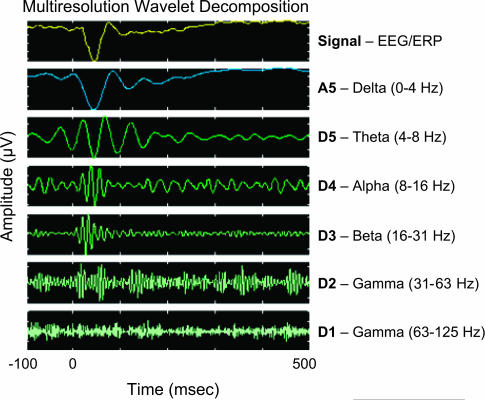Fig. 1.
Five-level multiresolution decomposition of a human averaged auditory event-related potential (ERP) based on the discrete wavelet transform (DWT), using the Daubechies D5 wavelet as a mother wavelet. The application of a 5-level, dyadic DWT decomposes the scalp-recorded event-related electroencephalogram (EEG) signal (upper panel) in the time-frequency plane at different resolution levels, or scales, into a set of basic orthogonal individual signal components (lower panels) that approximately correspond to the main rhythmic activities traditionally used to classify the ongoing EEG. The result of the DWT yields 5 detail functions and corresponding sets of wavelet detail coefficients (D1–D5), representing the energy of the EEG signal as a function of time in the 63- to 125-Hz (D1, gamma), 31- to 63-Hz (D2, gamma), 16- to 31-Hz (D3, beta), 8- to 16-Hz (D4, alpha), and 4- to 8-Hz (D5, theta) frequency bands, and one final set of wavelet approximation coefficients (A5), representing the activity of the remaining part of the signal in the 0- to 4-Hz (delta) frequency band. Note that the frequency band limits are rounded and that the y-axis is scaled differently for each frequency band. By applying the inverse DWT, the detail (D1–D5) and approximation (A5) signal components, as well as the original signal (ERP = A5 + D5 + D4 + D3 + D2 + D1), can be reconstructed from the wavelet coefficients for each scale.184,189 The ERP was recorded at the midline central scalp electrode from a healthy adult subject in response to task-irrelevant frequent standard 1000-Hz tones (100-ms duration, 10-ms rise/fall, using a variable interstimulus interval of 1300–1700 ms), while the subject performed a visual oddball task. The data indicate that the auditory ERP (upper panel) coincides with auditory transient-evoked (phase locked) oscillations in multiple frequency bands (lower panels), including early evoked gamma (31–63 Hz)-band responses that peak around 20 and 60 ms and an early evoked beta (16–31 Hz)-band response that peaks around 30 ms after tone onset.

